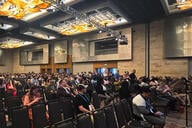You have /5 articles left.
Sign up for a free account or log in.
There is something deeply ironic in that Arthur Levine – who less than a decade ago wrote that teacher education programs were inadequate, the curriculum they follow incoherent, and the faculty who teach in them more or less incompetent – is now suggesting that competency-based education (CBE) will be the true future of higher education. The irony is heightened if one is aware (and which the op-ed strangely doesn’t acknowledge) that Levine is now leading an ambitious effort by the Woodrow Wilson Foundation to create a teacher preparation program through a competency-based model.
The irony is this: Levine has let go of one set or worries – the seeming inadequacy, incoherence, and incompetence of traditional teacher preparation programs – without acknowledging that his solution comes with its own set of worries that in the end may be much worse. For in all of the potential of a CBE model, there is the very real potential for creating an instrumentalism that presages a much more problematic outcome to the very institution of teacher preparation that he seemingly cares so much about.
Levine trots out some fairly standard (and tepid) arguments for the power of CBE. He suggests we are moving from an “analog” time-fixed system to one that values process and outcomes that are solely dependent on student mastery; that alternative pathways offer many more options for such program delivery (his among them! Though he doesn’t even mention that…); and that CBE will offer an unparalleled personalization since “Digital technologies offer unprecedented opportunities to individualize education to meet each student’s learning needs.”
I guess.
I would have focused much more on how CBE, if done right, is a perfect model for reverse-engineering the programs and competencies that students must indeed master. As good (and basic) instructional design teaches us, we should always start with our learning objectives in mind and develop the right assessments by which to figure out whether our students have indeed mastered such objectives. As I always tell my education students, John Dewey would have been just fine with teaching to the test if the test actually reflected what we wanted students to learn. And I would have added that when this is done in an online format within an adaptive learning management platform, it actually offers a pretty powerful means to support individual student learning.
But it’s almost irrelevant to mention the power of CBE if one doesn’t, in the very same breath, talk about its limitations. And this is where Levine falls short. Indeed, he is silent. The problem of a CBE-only model is that it is solely and only concerned with exactly what can be articulated through learning objectives and competencies. And for all of the good intentions of such a model – for we all need benchmarks and a quality-control “floor” to work from – it operationalizes a checklist-only framework of education.
I have referred to this in the teacher preparation world as missing the most important ingredient of preparing future teachers: we may give them the “opportunity to learn” and the “opportunity to practice,” but we neglect the critical importance of the “opportunity to change.” And if I can generalize this point, it thus becomes clear why AAC&U can’t seem to decide where it stands on CBE. Because while CBE contains some powerful pedagogical principles, in the end it cannot fully duplicate the heart of the liberal arts vision to develop thoughtful and critical citizens able to step outside and be pushed beyond their comfort zones of change.
What Levine has thus done is perpetuate Dewey’s worst fear: thinking in binaries. “Mankind,” Dewey wrote in his opening chapter to Experience & Education, “likes to think in terms of extreme opposites. It is given to formulating its beliefs in terms of Either-Ors, between which it recognizes no intermediate possibilities.” This is , unfortunately, exactly right about Levine. Levine has flipped from the problematics of traditional teacher preparation to flop seemingly in the nirvana of CBE. But there is no such thing.
I should note that I too am currently involved in developing a CBE-structured teacher preparation program. In so doing, I have watched how my faculty have begun to dis-assemble their face-to-face courses and re-engineer them within an online CBE framework. I have seen how a CBE framework supports and helps ground a licensure-centric model of teacher preparation in order to insure that there are some basic competencies and proficiencies that all future teachers should master and be held accountable for.
But on that same note, and in the same breath, I am also very clear that we must do more than an online-only, CBE-only model if we are to truly help our students become teachers. If we want to help future teachers – to help them see the larger picture of our educational system, grapple with the challenges of, yes, an all-too assembly-line model of education, and, in Marilyn Cochran-Smith’s evocative phrasing, “teach against the grain” – then we must at the very same time find hybrid models that can help us do so.
Namely, what I wish Levine would have said is that CBE does indeed offer some important opportunities, but only if we can figure out how to embrace the best of both the forthcoming digital revolution and meld it to what we already do well. Which is not to be blinded by the binary.
Dan Butin, PhD, is a Full Professor and Founding Dean of the School of Education & Social Policy at Merrimack College and the Executive Director of the Center for Engaged Democracy.



